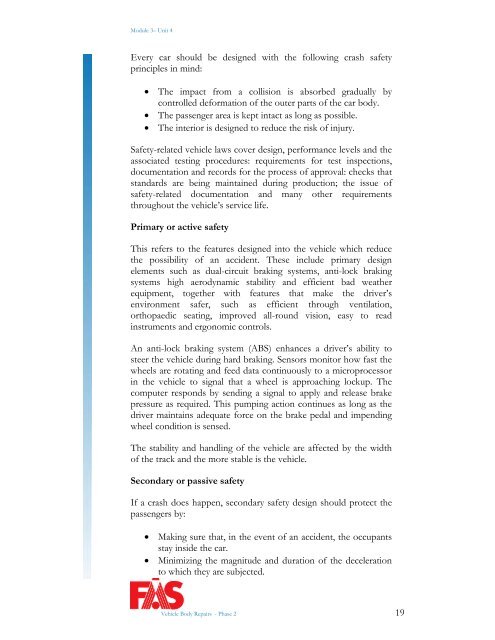TRADE OF VEHICLE BODY REPAIR - eCollege
TRADE OF VEHICLE BODY REPAIR - eCollege
TRADE OF VEHICLE BODY REPAIR - eCollege
You also want an ePaper? Increase the reach of your titles
YUMPU automatically turns print PDFs into web optimized ePapers that Google loves.
Module 3– Unit 4<br />
Every car should be designed with the following crash safety<br />
principles in mind:<br />
• The impact from a collision is absorbed gradually by<br />
controlled deformation of the outer parts of the car body.<br />
• The passenger area is kept intact as long as possible.<br />
• The interior is designed to reduce the risk of injury.<br />
Safety-related vehicle laws cover design, performance levels and the<br />
associated testing procedures: requirements for test inspections,<br />
documentation and records for the process of approval: checks that<br />
standards are being maintained during production; the issue of<br />
safety-related documentation and many other requirements<br />
throughout the vehicle’s service life.<br />
Primary or active safety<br />
This refers to the features designed into the vehicle which reduce<br />
the possibility of an accident. These include primary design<br />
elements such as dual-circuit braking systems, anti-lock braking<br />
systems high aerodynamic stability and efficient bad weather<br />
equipment, together with features that make the driver’s<br />
environment safer, such as efficient through ventilation,<br />
orthopaedic seating, improved all-round vision, easy to read<br />
instruments and ergonomic controls.<br />
An anti-lock braking system (ABS) enhances a driver’s ability to<br />
steer the vehicle during hard braking. Sensors monitor how fast the<br />
wheels are rotating and feed data continuously to a microprocessor<br />
in the vehicle to signal that a wheel is approaching lockup. The<br />
computer responds by sending a signal to apply and release brake<br />
pressure as required. This pumping action continues as long as the<br />
driver maintains adequate force on the brake pedal and impending<br />
wheel condition is sensed.<br />
The stability and handling of the vehicle are affected by the width<br />
of the track and the more stable is the vehicle.<br />
Secondary or passive safety<br />
If a crash does happen, secondary safety design should protect the<br />
passengers by:<br />
• Making sure that, in the event of an accident, the occupants<br />
stay inside the car.<br />
• Minimizing the magnitude and duration of the deceleration<br />
to which they are subjected.<br />
Vehicle Body Repairs - Phase 2 19
















